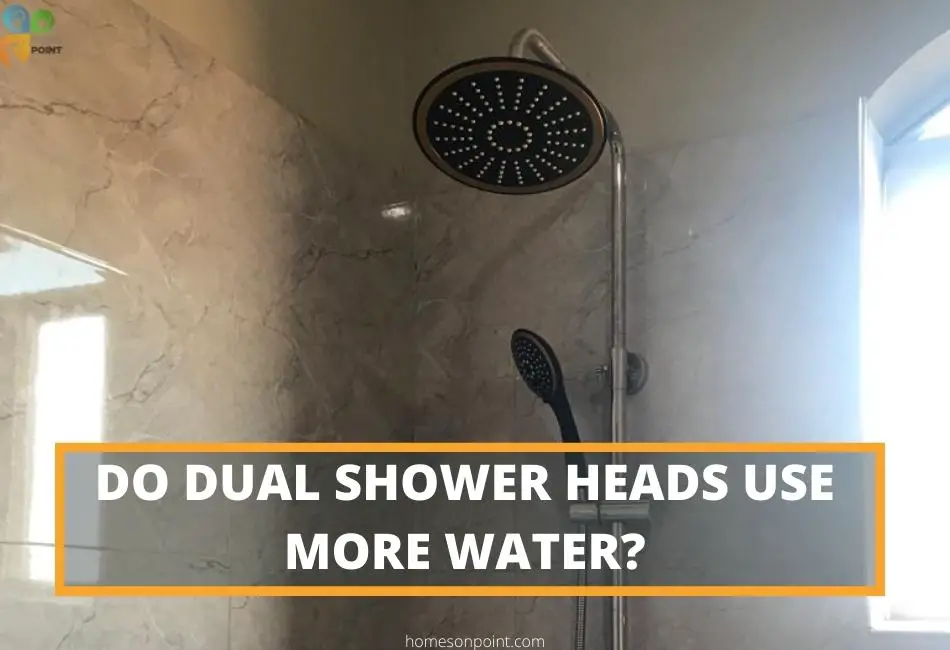In my previous article, I established the fact that you can have water running through your dual shower heads at the same time. Now, we have another question that needs clarification, which is if using the dual shower head at the same time uses more water or not.
The answer is yes and no. When you have high water pressure, using both shower heads at the same time uses more water. On the other hand, when you have a very low water pressure coming into your shower head, using both shower heads at the same time uses the same amount of water.
To come to this conclusion, I did some experiments on my own which I will get into it in the next chapters.
What are dual shower heads and how do they work?
A dual shower head is a shower fixture that contains two separate streams of water. They usually come in as wall-mounted and handheld shower heads. These dual streams allow you to customize your shower experience in a number of different ways, depending on the setting that you choose.
For example, you might use one stream for general cleaning and the other stream to target specific areas of the body, such as your face or back. Or you could adjust both streams to create a more relaxing experience.
Overall, dual shower heads are an innovative technology that provides numerous benefits to users seeking a more customizable showering experience.
Do dual shower heads use more or less water overall when both heads are used simultaneously?
There is considerable debate among experts regarding the issue of whether using dual shower heads uses more or less water overall than a traditional shower head does. There are some who argue that when both heads are used simultaneously, the water pressure will be lower, and therefore less water will be used per minute.
However, others contend that because dual shower heads can use up to 35% more water than a traditional head, using them together can actually increase overall water usage and lead to higher monthly bills for customers.
Despite these conflicting opinions, there does seem to be one key point on which most experts agree: careful analysis is needed in order to fully understand the dynamics at play in a standard dual shower head setup.
To further ascertain if dual shower heads use more water when used simultaneously, I did some experiments on my own.
The Experiment
We all agree the best way to know something is to test it out for ourselves. I use a water pump in my house to help with the water pressure because the normal water pressure without the pump is very weak.
So I did two different sets of experiments. One with the water pump turned on and one with the water pump turned off.
Here are my findings:
Experiment 1: With the water pump on
I conducted this experiment by placing a bucket under the shower heads and turning on both shower heads and letting them run till the bucket is full. I was timing to see how long it would take to fill the bucket.
It took me 59 seconds to fill the bucket with water using both shower heads.
In contrast, when I used only one shower head, it took 1 minute 18 seconds to fill the bucket with water.
This goes to show that when both shower heads are used at the same time with high water pressure, it uses more water.
To generate confidence in my experiment, I did this experiment 3 times to make sure my results were accurate.
Experiment 2: With the water pump off
I turned the water pump off for this experiment and just as I did with the first experiment, I placed a bucket of water under the shower heads and run water at the same time, timing to see how long it would take to fill the bucket up.
It took 4 minutes and 11 seconds for the bucket to fill with water using both shower heads. Surprisingly, when I used only one shower head, it took me almost the same amount of time to fill the bucket. To be specific it took me 4 minutes and 15 seconds to fill the bucket.
Comparing these two results, we can see that when both shower heads are used at the same time, with low water pressure, water usage is almost the same.
Experiment Summary
The conclusion drawn from the experiment is that when both shower heads are used together, it uses more water only when the water pressure is high. This is on the assumption that you spend the same amount of time showering with both shower heads as you would with one shower head.
On the other hand, If the water pressure is low, using both shower heads at the same time does not use more water.
Other Factors That May Affect Water Usage
There are a few other factors that could potentially affect the amount of water used when using dual shower heads. These include
1. Clog in the shower head
A heavy build-up in a shower head restricts the free flow of water through it. As a result, water may take longer to come out of the shower head, and this could lead to an increase in water usage.
So when there is a clog in any of the shower heads or both, using both shower heads at the same time wouldn’t use more water because the water is finding it difficult to come out.
2. The presence of a flow restrictor
Most shower heads have a flow restrictor which is a small disc with tiny holes in it. It is placed in the shower head to help conserve water.
When the flow restrictor is in place, it restricts the amount of water that comes out at a time.
3. The type of shower head you are using.
Some shower heads are designed in such a way that they use less water than others. For example, shower heads with an aerating feature mix air with water droplets. As a result, this type of shower head uses less water but still provides a good showering experience
Final Words
It is important to be mindful of the amount of water we use because it is a precious natural resource. We should only use as much water as we need and not waste it.
If you have very high water pressure, using both shower heads at the same time would use more water if you spend the same amount of time showering.
I hope this article has been informative. Thanks for reading.

